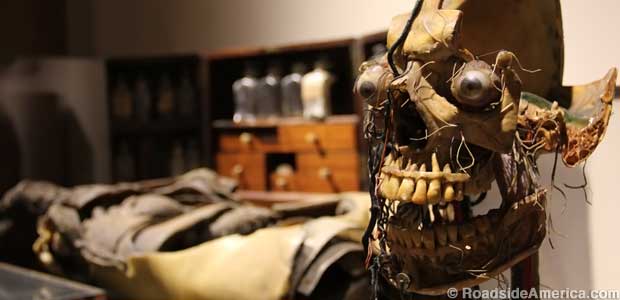
Blood vessels on the left, nerves on the right. Partly de-fleshed skull was a medical teaching tool in the 1830s.
Transylvania's Moosnick Museum
Lexington, Kentucky
"I've been called The Hairball Guy," said Dr. Jamie Day, professor of physics and caretaker/curator of the Moosnick Museum at Transylvania University. The hairball is the most famous artifact in this little-known collection, a brown orb as big as a birthday balloon that was pulled from a cow's stomach in 1848. Dr. Day calls it the "world's most politically-connected hairball." It was donated to the university by Abraham Lincoln's brother-in-law.
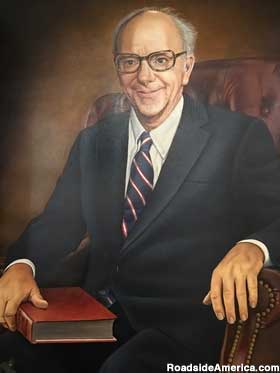
Museum namesake Dr. Monroe Moosnick devoted 40 years to the collection.
"At the time," said Day, "people believed that if you held a hairball against a wound, it would suck the poison out."
The medicinal link is important, because the Moosnick Museum is a collection of early 19th-century medical curiosities, from a time when Lexington's Transylvania University had one of the top doctor-training schools in the country. The school closed in 1859 -- in part because little Lexington had relatively few dead bodies to dissect -- then it became an Army hospital and burned during the Civil War. Its priceless teaching tools -- including weird electrical instruments, preserved body parts, unsettling anatomical models, countless dead animals, and the hairball (which appears to be lightly scorched) -- were rescued from the flames. Then they disappeared into Lexington's closets, cellars, and attics.
"Had the school remained open," said Day, "all this crazy stuff would have eventually been thrown out and replaced with newer stuff." That didn't happen, and by the time the collection was reassembled at the University in the 1920s, it was recognized as historical and worthy of display.
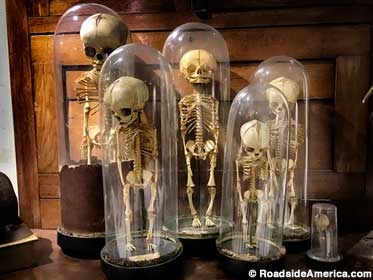
Fetal skeletons under glass.
Dr. Day opened a cardboard box to reveal three perfectly preserved human penises. "Why would someone save these from a fire?" he asked himself. Then he thought of an answer. "Well, they're portable."
This peek-a-boo approach has followed the collection throughout its post-inferno history, with various objects reappearing at times from cartons, shelves, and storage rooms. "It's kind of random," said Day. "Somebody along the way will find something and say, 'Oh, this shouldn't be here,' and stick it in the museum."
Dr. Day recalled that someone was once searching through the biology collection, "looking for odd things like a two-faced kitten -- we have one of those -- and then this jar of meat surfaced." The meat is supposedly a preserved sample of a shower of meat that fell out of the sky about 30 miles east of Lexington on March 2, 1876. "It's a cool, creepy artifact," said Day the curator, although Day the physics professor remains a meat shower skeptic.
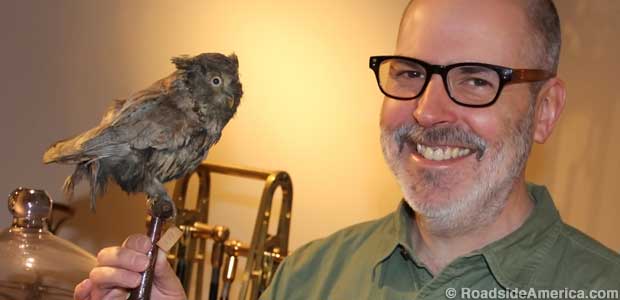
Curator Dr. Jamie Day and one of the museum's countless dead birds.
Another discovery, this one by Day himself, was "Medical Venus," a female anatomy model whose lifelike tissues and organs were cast in wax from as many as 200 cadavers. "It really freaked me out," said Day, who had climbed to a top shelf in a University building basement and found himself staring into Venus's one remaining eye. The model, like others in the collection, which range from partly-fleshed skulls to a two-headed baby, were made as real as possible to lessen the need for corpses, which the desperate students at Transylvania sometimes acquired by digging up Lexington's graves.
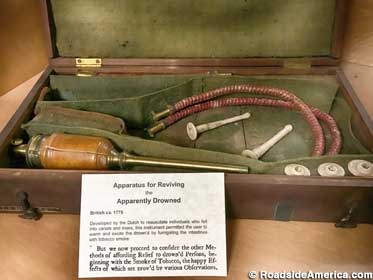
This device pumped tobacco smoke up the rectums of drowning victims to shock them back to life. Supposedly.
Nearly every item in the museum has been corroded by soot or dust or fire, and yet it's amazing how many -- some over 200 years old -- have survived, from delicate uteruses made of paper, to a model of a Chinese man with a parasitic twin, to a phrenology skull with a dissectible brain, to a device used to revive drowning victims by blowing hot tobacco smoke up their rectums. "We have lots and lots of weird things," said Day. He recalled "one of the creepiest spaces I've ever been," a dark room on campus full of giant cardboard boxes, "packed to the brim with 150-year-old-birds coated with arsenic. Probably thousands of birds."
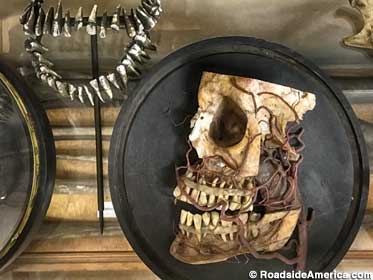
Real or fake? Sometimes even experts can't be sure.
We asked Day if these kinds of experiences kept him awake at night. He said no; academic politics could be far more nightmarish than boxed birds or a two-headed baby.
Ironically, the museum's most fire-and-dust-proof relic, a 13-foot-wide mechanical planetarium built in Lexington, did not survive; it collapsed under its own weight after a trip to a 19th century World's Fair. The museum displays some of its massive pieces, and Day said that he hopes to restore the broken parts with the help of a 21st century 3-D printer and some 19th century Amish ironmongers.
The Moosnick Museum's artifacts are currently displayed in multiple campus locations. Dr. Day said that the University has intended since the 1940s to consolidate the collection into into a single "museum" space, but its vast size and a lack of funds has continually thwarted those plans. "I appreciate that the administration lets me do this," said Day, "but I hope in my lifetime that a donor comes along and says, 'Let's do this right.' I'll lose my position as curator, but I'm okay with that."
Would he consider becoming an exhibit in some far-future Moosnick Museum? "I have thought about it," said Day. "But I try not to too often."





